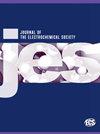Silicon-Based Nanocomposite Anodes with Excellent Cycle Life for Lithium-Ion Batteries Achieved by the Synergistic Effect of Two Silicides
IF 3.3
4区 工程技术
Q2 ELECTROCHEMISTRY
引用次数: 0
Abstract
Nanocomposite electrodes comprising LaSi2 and Si exhibit satisfactory charge–discharge cycling performances but their capacity is degraded after repeated cycles. A metallographic structure, in which the Si phase was finely dispersed in the LaSi2 matrix phase, was formed before cycling. The elastic LaSi2 relieved Si-generated stress and suppressed electrode disintegration. Contrarily, the LaSi2 phase in the metallographic structure was surrounded by the Si matrix phase after cycling. The positional relationship between the two phases was reversed, and LaSi2 could not relieve the stress. For a nanocomposite electrode containing CrSi2, which exhibits stiffness to withstand the Si-generated stress, the structural changes were suppressed after cycling, resulting in good cycling stability. Here, we considered that the addition of stiff silicides as a third phase to the LaSi2/Si composite could improve the cycle life. Thus, this study prepared nanocomposite electrodes containing elastic LaSi2, stiff MSi2 (where M = Cr, Mo, Nb, Ta, Ti, or W), and elemental Si and investigated their electrochemical performances. Reaction behaviors, such as the metallographic structure, electrode thickness, and phase transition, were also clarified. The LaSi2/NbSi2/Si electrode exhibited the best cycle life without changes in its metallographic structure owing to the synergistic effect of stiff and elastic silicides.通过两种硅化物的协同效应实现具有出色循环寿命的硅基纳米复合材料锂离子电池阳极
由 LaSi2 和硅组成的纳米复合电极表现出令人满意的充放电循环性能,但反复循环后容量会下降。在循环前形成了一种金相结构,其中硅相精细地分散在 LaSi2 基体相中。弹性 LaSi2 可缓解硅产生的应力,抑制电极解体。相反,金相结构中的 LaSi2 相在循环后被硅基相包围。两相之间的位置关系发生了逆转,LaSi2 无法缓解应力。对于含有 CrSi2 的纳米复合电极,由于其具有承受硅产生的应力的硬度,循环后结构变化被抑制,从而获得了良好的循环稳定性。在此,我们认为在 LaSi2/Si 复合材料中添加硬硅化物作为第三相可以提高循环寿命。因此,本研究制备了含有弹性 LaSi2、硬质 MSi2(其中 M = Cr、Mo、Nb、Ta、Ti 或 W)和元素 Si 的纳米复合电极,并研究了它们的电化学性能。此外,还阐明了金相结构、电极厚度和相变等反应行为。由于硬硅化物和弹性硅化物的协同作用,LaSi2/NbSi2/Si 电极显示出最佳的循环寿命,且其金相结构未发生变化。
本文章由计算机程序翻译,如有差异,请以英文原文为准。
求助全文
约1分钟内获得全文
求助全文
来源期刊
CiteScore
7.20
自引率
12.80%
发文量
1369
审稿时长
1.5 months
期刊介绍:
The Journal of The Electrochemical Society (JES) is the leader in the field of solid-state and electrochemical science and technology. This peer-reviewed journal publishes an average of 450 pages of 70 articles each month. Articles are posted online, with a monthly paper edition following electronic publication. The ECS membership benefits package includes access to the electronic edition of this journal.

 求助内容:
求助内容: 应助结果提醒方式:
应助结果提醒方式:


